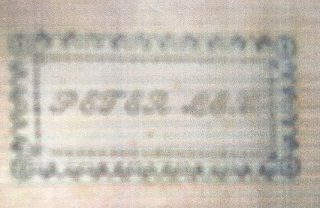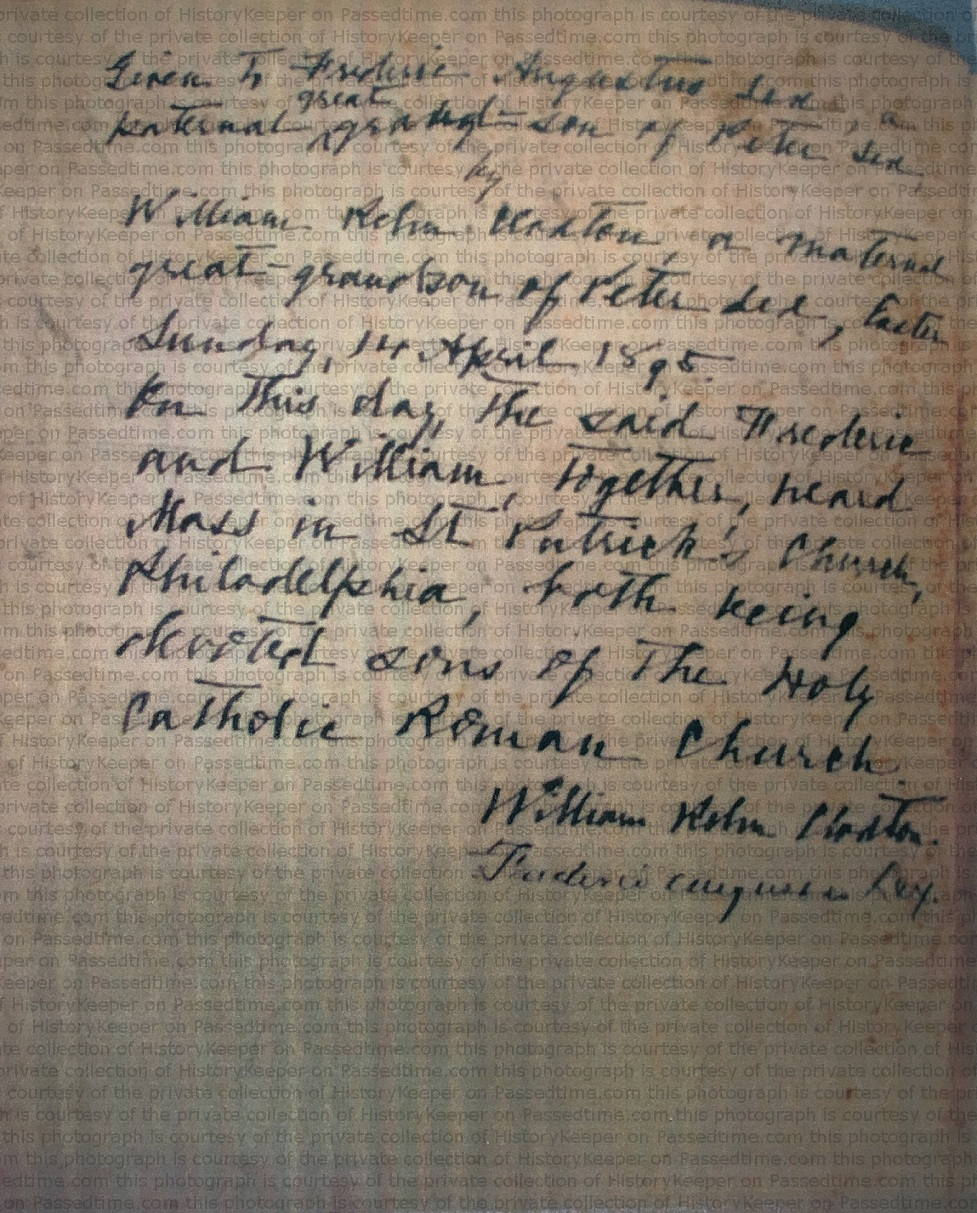Image Courtesy of Earnest Archives and Library
 We recently [2013] came across notes written on blank pages of a copy of Johann Arndts’ Sechs Bücher vom Wahren Christenthum (Six Books of the True Christendom). Published in Nürnberg in 1762, the book was purchased in Philadelphia in 1783 by Peter Lex, who apparently penned the notes himself in German script. According to Lex, he was born on August 30, 1750 in “Gemein Schafftlichen Flecken Wöllstein beÿ Creutznach” (the little community [of] Flecken Wöllstein near [Bad] Kreuznach) in the Rheinland Pfalz area of today’s Germany. He bought his book in November 1783 for 1 pound, 17 shillings, and 6 pence.
We recently [2013] came across notes written on blank pages of a copy of Johann Arndts’ Sechs Bücher vom Wahren Christenthum (Six Books of the True Christendom). Published in Nürnberg in 1762, the book was purchased in Philadelphia in 1783 by Peter Lex, who apparently penned the notes himself in German script. According to Lex, he was born on August 30, 1750 in “Gemein Schafftlichen Flecken Wöllstein beÿ Creutznach” (the little community [of] Flecken Wöllstein near [Bad] Kreuznach) in the Rheinland Pfalz area of today’s Germany. He bought his book in November 1783 for 1 pound, 17 shillings, and 6 pence.
Lex’s notes are interesting for several reasons. He spoke about 1783 being the year that the republic gained its freedom from the King of England, and how the fledgling American congress would meet in December. Congress had proclaimed the end of the Revolutionary War on April 19, and it did meet, as noted by Lex, in Annapolis on December 23 to accept George Washington’s resignation as commander-in-chief.
Image Courtesy of Earnest Archives and Library

Obviously concerned about the future of his new country, Lex ended his remarks about gaining independence from England with, “O Herr hilf, O Herr laß wohlgelingen” (O Lord, help [us], O Lord, let [us] succeed). It is rare to discover words from a little-known citizen expressing worries about the future at such a critical time in American history. Lex had justification for his anxieties, for the newly formed country slid into a post-war depression that lasted four years. Of course, Lex’s future is our past, but it turned out to be one of hope, prosperity, and fulfilled promises. However, to Lex in 1783, the future was a blank page with success yet to be written on fragile paper.
Lex and his posterity fared well in America, so much so that we wish he could have lived to see it (he died in 1831). Some of his progeny married into prominent families. Lex, himself, became a merchant in Philadelphia. In 1779, he married Elizabeth Rathschlag. The Lex family lived on Market Street in Philadelphia where it is said he became a butcher, grocer, and sugar refiner. A portrait of him has been attributed to portrait painter, John Paradise (1783-1833), and is said to have descended in the Mary Custis Lee family (great granddaughter of Martha Washington and wife of Robert E. Lee).
Other notes written on blank pages of Lex’s newly purchased book were penned by his descendants, William Rehn Claxton and Frederic Augustus Lex. They recount how the two attended mass together on Sunday, April 14, 1895 at St. Patrick’s Church in Philadelphia. They note that they were “devoted sons of the Holy Catholic Roman Church,” and that Frederic Augustus Lex was a great grandson of Peter Lex. Image Courtesy of EAL
William Rhen Claxton (1850-1915) was descended from Peter Lex as well. Claxton was a great grandson of Lex on his maternal side. His parents were Edmund Claxton (1817-died after 1870) and Elizabeth Lex Rehn (ca. 1838-died after 1850). In 1890, William Rehn Claxton married Emily Aimee Marie Louise LaFarge (1862-1919), daughter of John LaFarge (1835-1910), who became known for painting murals and creating stained glass windows. LaFarge’s wife was Margaret Mason Perry of Rhode Island. On her paternal side, she was a granddaughter of Commodore Oliver Hazard Perry. On her mother’s side, Margaret Mason Perry was descended from Chief Justice Thomas Sergeant and from Benjamin Franklin.
Much of Peter Lex’s history is recorded in the papers of the Jacob and Mary (Rathschlag) Hansell family and in the papers of the Claxton family of Philadelphia. Peter Lex’s brother-in-law, Jacob Hansell, was a Philadelphia blacksmith and John Claxton was a Philadelphia merchant and shipper. The Claxton family papers date from 1740 and are at the Historical Society of Pennsylvania (coll. 2152). There are some 300 items in these papers including Elizabeth Lex’s account book that dates from 1831 (the year Peter died) to 1845. Rehn family papers are also in the Claxton file.
We happened across Lex’s book at an ephemera sale. Somehow, it is startling to read the private thoughts from a little known Philadelphia merchant who witnessed the Revolution – more so than it is to read something recorded by a famous American. To know Lex wrote his lines in “real time” as events unfolded makes his words all the more poignant. Ultimately, he got his wish. We did succeed. Corinne Earnest ,September 2013
*The above was originally printed in the September 2013 Earnest Archives and Library Newsletter by Corinne Earnest.1 Family members have recently requested information on the whereabouts of the book. Unfortunately, its current location is unknown. For the family, and interested readers, I have provided additional photos.2
1 Reprinted with permissions
2 The photographs were taken on site at an auction. Unfortunately, they are the only pictures we have.
Image Courtesy of Earnest Archives and Library
Image Courtesy of Earnest Archives and Library
Comments (95)
-
Guest - smith
PermalinkPiramal Aranya, a residential project, offers lavish 3 bhk flats in south mumbai. These dwellings come with state-of-the-art amenities and are designed to offer a luxurious lifestyle. If you want to flat in byculla, you must check out this project. For more detail, you can call us at +91 226 849 3138
0 Like -
0 Like
-
-
I admire this article for the well-researched content and excellent wording. I got so involved in this material that I couldn’t stop reading. I am impressed with your work and skill. Thank you so much. hotmail.com login
0 Like -
Guest - ghazanfar
PermalinkI recently found many useful information in your website especially this blog page. Among the lots of comments on your articles. Thanks for sharing. http://199.30.55.95/
0 Like -
Positive site, where did u come up with the information on this posting?I have read a few of the articles on your website now, and I really like your style. Thanks a million and please keep up the effective work.
0 Like -
Positive site, where did u come up with the information on this posting?I have read a few of the articles on your website now, and I really like your style. Thanks a million and please keep up the effective work.
0 Like -
Guest - daisygosia
Permalinkit's good article, i have confirmed and searched for it for days word finder
0 Like -
Pretty good article. I just stumbled across your blog and wanted to say that I really enjoy reading your blog posts. I hope you will post again soon. Thank you very much for the useful information.
girls games0 Like

Leave your comments
Login to post a comment
Post comment as a guest